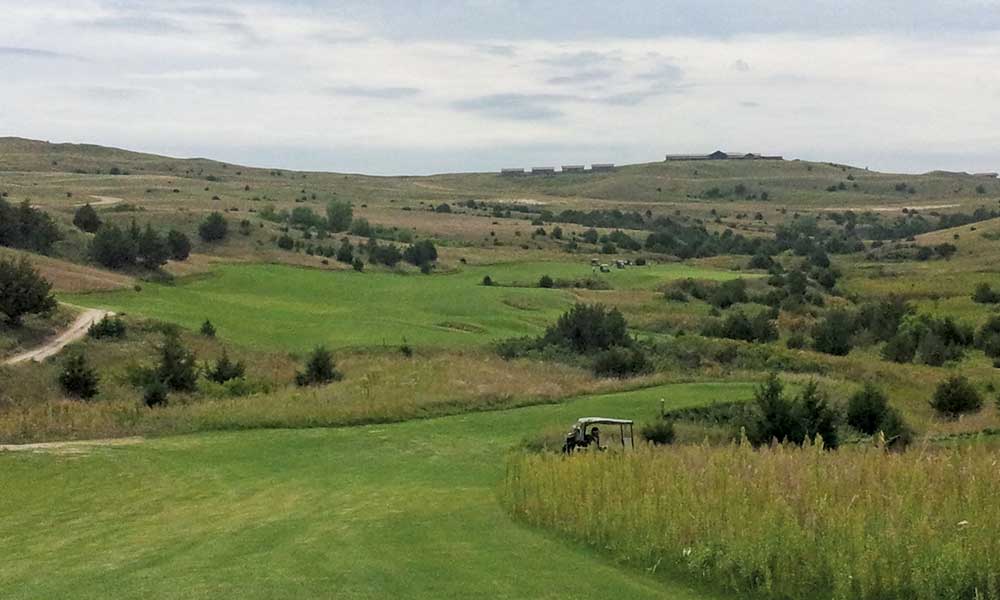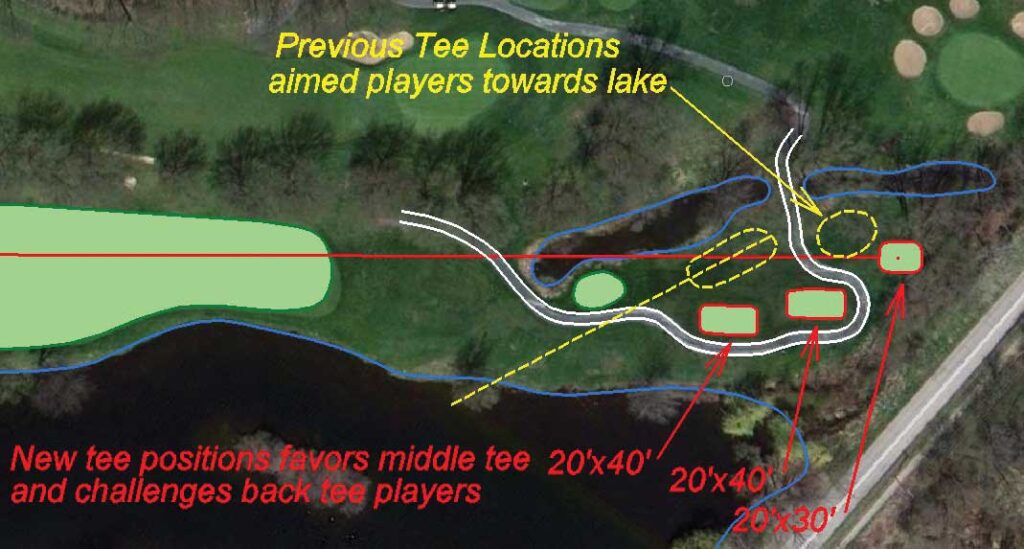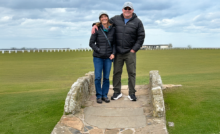

Red course at Dismal River
Tees
The oldest joke in the golf course design business is you have to show the golf course architect to the first tee on opening day. It sounds ridiculous, but from the time grass seed goes down to the opening day the clubhouse and surrounding areas go up creating an unrecognizable transformation. There are numerous factors that go into placing the tees and when done properly can maximize the enjoyment for all types of golfers while minimizing the burden of the golf course superintendent.
Location
For the new course, construction siting tee locations should begin with the middle tee. Many designers choose to design from the back tee, but since most of the play will occur from middle tees they should be given priority. From the middle tee, ideally, the back tee should be placed with a slightly more challenging angle to the fairway or hazard.
Likewise, forward tees are placed to allow for the best angle of play. For existing courses, changes in technology and players’ needs require that all clubs reevaluate tee locations. The typical response is to add back tees, but upon further review, the majority of players need to play the course shorter. I recommend clubs determine player needs and create an ideal scorecard personalized for each tee type. An ideal scorecard should have a variety of short and long holes giving each player the opportunity to use every club in the bag. Generally, courses seem to have an abundance of holes around 380-400 yards. To add interest, I recommend shortening select holes that offer risk-reward strategies. Concerns arise about defending par, but I always argue, no one ever quits golf because it was too easy. Once an ideal scorecard is completed, priority can be set to changes and tees adjusted or added over time.


At Long Beach Country Club the course is built on a combination of sand dunes on the southern shore of Lake Michigan and peat bogs. Areas within the former peat bogs suffer from settling and tee were especially unleveled. As one member told me “The tees have more contour than the greens”. The club took the opportunity to not only re-level some tees but also realign them to improve shot angles and offer different lengths. Because the overall length of the course was short at 6,570 the majority of the membership played the back tees. We took this as an opportunity to create a black tee and move the blue tee forward creating better playing selections for the membership.
Size
The term “tee box” comes from the beginning of golf in Scotland. Boxes of moist sand were placed at the beginning of each hole. The sand was mounded up and the ball placed on top. It wasn’t until the 1920s with the introduction of the “Ready Tee”, a small wooden peg, that the modern golf course tee was adopted. When hitting off of sand the condition of the teeing ground was of little concern, but today’s golfer has greater expectations. To ensure adequate teeing ground the historical rule of thumb for sizing tees is 100 sqft per 1,000 rounds per year per hole. That number is doubled on par 3’s, the 1st and 10th hole. Presuming a typical par 72 with 32,000 rounds annually the total tee space would be 76,800.
1st hole – 2×3200 = 6,400
10th hole – 2×3200 = 6,400
par 3’s – 2x4x3200 = 25,600
Remaining holes 12x 3200 = 38,400
Grand total 76,800 sqft
For golf courses in seasonal markets, a better way to estimate size is 1 sqft for each player on its busiest month per hole. Presuming a typical par 72 with the play of 5,000 rounds in the peak month the total tee space would be 90,000sqft.
1st hole 2×5000 = 10,000
10th hole 2×5000 = 10,000
par 3’s 2x4x5000 = 40,000
remaining holes 12×5000 =60,000
Grand total = 120,000 sqft
Further complicating the size question is the five tee system that has been adopted to help accommodate players of every skill level. The smallest desired tee size is 600 sqft for separate forward or back tees. Over 18 holes this could add another 21,600 sqft (2x600x18) to the total teeing area. To balance the tee size with preferred distance golf course designers look to combine tee boxes which is the reason for handicapping each set of tee boxes.
Shape
Tees are maybe the most artificial element in golf, but even well-designed tees tend to stand out of the existing environment. During a recent trip to the Sand Hills region of Nebraska, I played the new Red course at Dismal River. The course takes minimalist design to a new level by maintaining only greens and fairways. The fairway cuts surrounding the greens blend seamlessly into teeing grounds which are designated by yardage posts. Golf carts are allowed directly on teeing areas to encourage speed of play. These grounds seem to be mostly native contours and offer flat or sidehill lies. Beyond creating unique teeing grounds the one height cut reduces specialized turf equipment and streamlines cultural practices.
To achieve similar efficiencies results on existing courses, the tee should have plain shapes avoiding triangles or free-formed. Whatever gets maintained should be useable space. Tee widths should be matched to turf equipment. Typical sprayers have a width of 17’-20’ while Triplex mowers range from 5’-7’. Ideally, a 20’ wide tee would require only one pass with sprayer and three passes with the wide deck tri-plex mower.
In this current era of tight budgets and overextended staff, golf course superintendents are required to maximize resources. Proper size, shape, and location of the teeing area can help save just a few minutes a day, but those minutes may give the staff flexibility to tackle the next task and be more productive.
Joe is the principal at Jemsek Golf Design. Started in 2000 to design, renovate, and restore golf courses around the world. Joe has worked with many other golf course architects, on over 90 projects, in 29 countries. Jemsek Golf Design is dedicated to designing and constructing innovative, accessible, and eco-friendly golf courses worldwide. My goal is to deliver services on time, adhering to a proposed budget, and respecting the surrounding natural environment. www.jemsekgolfdesign.com
Recent Posts
Memphis Country Club: A Golfer’s Study in Precision and Tradition
If you have ever teed it up at Memphis Country Club, you know this isn’t…
Foley Company attains GCSAA Silver Partner Status
Foley Company, a leader in turf equipment innovation and technology, affirms its support of the…
Harrell’s continues longstanding support of the GCSAA Foundation
Harrell’s LLC, a leading distributor of customized agronomic products for turfgrass since 1941, has donated…
City of Orlando Announces New State-of-the-Art Driving Range at Dubsdread Golf Course
The City of Orlando is excited to announce the construction of a brand-new, state-of-the-art driving…
Discover Puerto Rico for Great Golf Trips and After-Round Activities, Amenities
Golfers cannot live by the game alone which is why Puerto Rico provides the perfect…
Q&A with a Multi-talented Golf Course Architect – Part 2: Making the Rounds – Installment 39
This column features recollections of the author’s 37 years as a golf writer. These installments…


